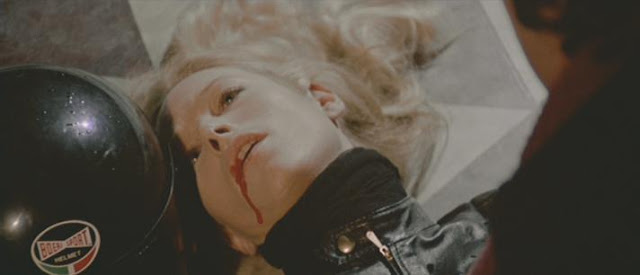
The European cinematic movement of the 1960’s and ‘70s known as the giallo would eventually help kick start the slasher movement in the United States. And, like the slasher movement, gialli could often result in solid, respectable titles worthy of critical appreciation, but they could often vie for much less, wanting to offer their audiences nothing more than pulpy thrills and vapid, surface-level entertainment. That’s where Strip Nude For Your Killer lives. All the stalwarts of the giallo are there: the heightened murder sequences, the too-red blood, the overt sexuality, and of course, the mysterious, black-clothed killer. However, instead of a complex plot with lots of moving parts a la The Bird With The Crystal Plumage, Strip Nude For Your Killer offers a far less complex plot that’s tantamount to Agatha Christie by way of Scooby Doo: Someone is killing off the staff at a fashion studio in Milan and it’s up to photographer Magda (Edwige Fenech) and her boyfriend/also-photographer Carlo (Nino Castelnuovo) to find the identity of the killer before they’re next on the chopping block.

Featuring a short-haired Fenech, who was a popular face in a dozen films in the Martino Brothers’ oeuvre (Luciano, producer, and Sergio, director, which includes their classic All The Colors Of The Dark), Strip Nude For Your Killer is one of the trashier giallo titles to hail from this era. The level of violence on hand is fairly tame considering what other filmmakers were doing at this time (A Bay of Blood had come out four years prior and was far more violent), but where lacks in grue and gore it more than makes up for with its sexuality. Depending on your sensibilities, Strip Nude For Your Killer falls either directly within or hues very closely to soft-core entertainment. And you get it all: straight sex, lesbian sex, gross fat sex, and sex that, in today's standards, is probably rape. Fenech likely spends more time walking around topless than she does fully clothed (I’m fine with it), and everyone is either sleeping with or wants to sleep with everyone else.
There is enough intrigue established that you can invest yourself in the goings-on of the plot, even if that investment is limited to, “Gee, I wonder who the killer is?” Subtextually, there’s nothing else to grasp onto. However, simplicity of the plot aside, Strip Nude For Your Killer offers fascinating characterization. Fenech’s Magda embodies the responsibilities of the final girl, but while leaving behind the chasteness that usually comes with it. She is a feminine force who knows what she wants and is willing to play the bad girl in order to get it. Castelnuovo’s Carlo, however, is a malignant prick — pompous, shallow, misogynistic, and downright unlikable for nearly the entire running time. Complicating this a tiny bit is that he’s also the hero. Or, at least, heroically involved in trying to find the identity of the killer. It’s a bold move hinging your murder mystery on two characters who present atypical qualities from what we’re used to from the genre. They are essentially Sam Loomis and Lila Crane from Psycho, only they bang a lot. (Of course, I can always upend this argument by saying John Carpenter’s Halloween was still three years off, which would cement the archetype of the “final girl” and all the rules that came with it.) Still, making your heroes slutty and self-absorbed is a fun idea no matter if the filmmakers are circumventing expectation or not.

The killer’s presence looms large over the proceedings, although he doesn’t appear on screen very often. When he does, he’s clad in skin-tight motorcycle leather, complete with helmet, a design that would be used again in future gialli titles like Massimo Dallamano’s What Have They Done to Your Daughters? and Umberto Lenzi’s giallo/slasher hybrid Nightmare Beach a.k.a. Welcome To Spring Break. Director Andrea Bianchi, who would go on to direct the ultimate garbage classic Burial Ground: The Nights Of Terror, shows off minimal style, allowing his characters (and their nudeness) to do most of the work. The resolution to the story, preempted by the reveal of the killer, unfolds a little too quickly, forcing you to remember the opening that also unfolded a little too quickly, threatening an audience reaction of “Who?” when the motorcycle helmet is finally removed to reveal the killer’s identity. But none of this matters because the film ends-ends with one of the best, most tasteless “jokes” I’ve ever seen in any genre. Thanks, the Italians!
For every Psycho or Halloween, there are tiers of slashers made in the same mold that vie for a different experience. Strip Nude For Your Killer is the Friday The 13th: A New Beginning of the giallo movement. Its plot is inconsequential, its performers are happy to disrobe, and its characters are broadly painted archetypes who are all apparently sleeping with each other. Oh, and it’s trashy as hell. Of course, there’s nothing wrong with this — just know what you’re getting yourself into before you sit down to watch. (And if you’re already a fan of gialli, then you definitely should.)
[Reprinted from Daily Grindhouse.]





















